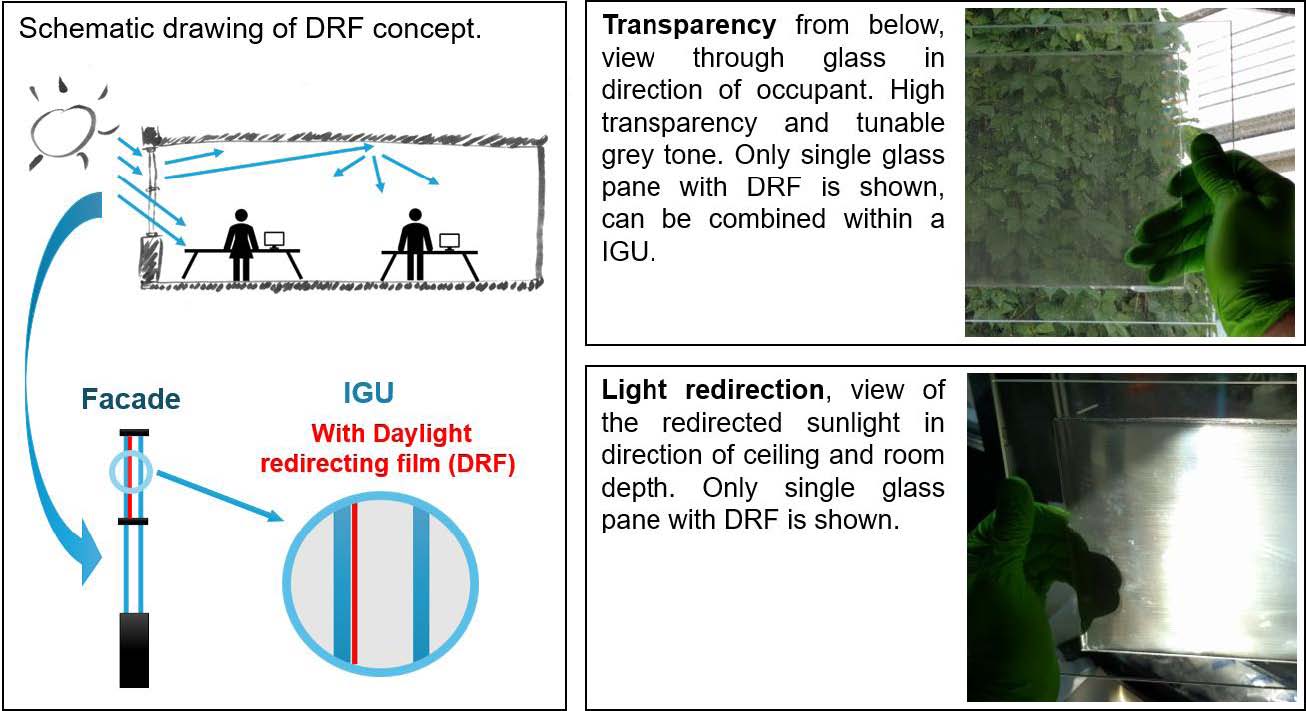Brief Concept Description
DARE is a newly developed daylight redirecting film that can overcome the most common limitations of existing daylighting redirecting films: limited efficiency, insufficient glare protection, unappealing aesthetic appearance, high cost and complex installation. With this innovative solution, glare protection is provided most of the year (during more than 90% of office hours) and the efficiency is increased based on a different technology, without the use of prisms or air cavities and with the use of encapsulated metallic micromirrors. This enables lamination into the glazing and the aesthetic appearance is improved since the film remains transparent under the most common viewing angle and the cost is reduced by an early and facilitated integration into glazed products. The DARE daylight redirecting film is currently in an advanced stage of development.
Architectural and Technological Integration into the Envelope
The film is integrated inside double or triple glazing units mounted above viewing height (skylight - approx. 2 m and above), as shown in Figure 69. The integration into portions of a continuous glazing is also possible. The system is completely passive and does not integrate any kind of actuator nor requires any active control. Once the film is integrated, the glazing units can be treated as conventional ones and does not need additional maintenance.

Figure 69. Schematic drawing of DARE daylight redirecting film concept and pictures of a prototype.
Integration into the Building: System and Comfort
The system improves the comfort conditions in the occupied space by providing glare protection and daylight redirection simultaneously. The daylight distribution on the floor space is enhanced and the daylight autonomy is strongly improved, in particular in room depth where it can be improved by 50% to 150% depending on the location. A simulation study on a number of locations worldwide showed that in average it is possible to achieve an improvement of daylight autonomy of 66% and energy savings for artificial lighting of 38%, corresponding to an average reduction of primary energy consumption in buildings fulfilling an efficient energy standard of 16%.
Lessons Learned
The aesthetic of a product is essential for acceptance in the building sector.
Further Reading
Gong, Jing ; Kostro, André Gabriel ; Motamed, Ali ; Schueler, Andreas . Potential advantages of a multifunctional complex fenestration system with embedded micro-mirrors in daylighting, Solar Energy Journal, 139, 412-425, 2016. https://doi.org/10.1016/j.solener.2016.10.012
A. Kostro, P. Couty, D. Geisler Moroder, W. Pohl, A. Schüler, A. Hafner. From university to industry - challenges in upscaling optical microstructures for daylight redirection in buildings, to be published in proceedings of CISBAT 2019.https://doi.org/10.1088/1742-6596/1343/1/012194